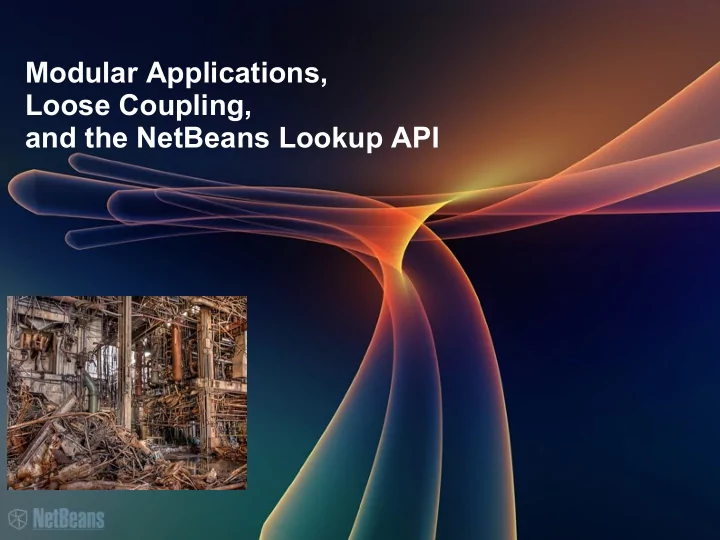

Modular Applications, Loose Coupling, and the NetBeans Lookup API
The Need for Modular Applications Certified Engineer Course
The Need for Modular Applications Certified Engineer Course
The Need for Modular Applications • Applications get more complex • Assembled from pieces • Developed by distributed teams • Components have complex dependencies • Healthy architecture: > Know your dependencies > Manage your dependencies Certified Engineer Course
The Entropy of Software • Version 1.0 is cleanly designed... Certified Engineer Course
The Entropy of Software • Version 1.1...a few expedient hacks...we'll clean those up in 2.0 Certified Engineer Course
The Entropy of Software • Version 2.0...oops...but...it works! Certified Engineer Course
The Entropy of Software • Version 3.0...Help! Whenever I fix one bug, I create two more! Certified Engineer Course
The Entropy of Software • Version 4.0 is cleanly designed. It's a complete rewrite. It was a year late, but it works... Certified Engineer Course
The Entropy of Software • Version 4.1...does this look familiar?.... Certified Engineer Course
The Entropy of Software • TO BE CONTINUED.... Certified Engineer Course
Modular Applications • Discover their components at runtime • May add/remove/reload components at runtime • Must satisfy dependencies between components • Have API contracts between components • Run inside a runtime container Certified Engineer Course
What Does a Runtime Container Do? • Application lifecycle > Starts and exits your application > Modules are installed and ununistalled • Module discovery and management • Classloading and code isolation • Service registration/discovery facility Certified Engineer Course
What is the NetBeans Runtime Container? Certified Engineer Course
What is a NetBeans Module? • It is just a JAR file – no magic > Has some special manifest entries to describe it to NetBeans > Editable in the Project Properties dialog for module projects • Distributed in an NBM file > Basically a signed JAR file > Contains metadata about the module > May contain 3 rd party JARs or anything else that needs to be on the system Certified Engineer Course
NetBeans Module Manifest Manifest-Version: 1.0 Ant-Version: Apache Ant 1.7.0 Created-By: 1.5.0_14-b03 (Sun Microsystems Inc.) OpenIDE-Module-Public-Packages: - OpenIDE-Module-Module-Dependencies: org.netbeans.api.java/1, ... OpenIDE-Module-Java-Dependencies: Java > 1.5 OpenIDE-Module-Build-Version: 200804211638 OpenIDE-Module-Specification-Version: 2.12.0.4.1.1.6 OpenIDE-Module: org.netbeans.modules.java.editor/1 OpenIDE-Module-Implementation-Version: 4 OpenIDE-Module-Localizing-Bundle: org/netbeans/modules/java/editor/Bundle.properties Certified Engineer Course
NetBeans Module Manifest OpenIDE-Module-Install: org/netbeans/modules/java/editor/JavaEditorModule.class OpenIDE-Module-Layer: org/netbeans/modules/java/editor/resources/layer.xml OpenIDE-Module-Requires: org.openide.modules.ModuleFormat1 AutoUpdate-Show-In-Client: false Certified Engineer Course
Runtime Container Tasks • Ensure that dependencies are satisfied > Including requiring > version n of a module • Not allow illegal dependencies • Allow legal dependencies • Instantiate components of the system at runtime Certified Engineer Course
Enforcing Module Dependencies Certified Engineer Course
Use an Existing Runtime Container Rest In Peace, Home-made Frameworks 1995-2005 Certified Engineer Course
Module Dependencies Certified Engineer Course
The Java Extension Mechanism (almost it) • In JDK since 1.3 • Easy with JDK 6's ServiceLoader.load() • Declarative registration > No startup penalty • Plain-text file in META-INF/services > Name is interface > Content is FQN of implementation Certified Engineer Course
Demo: ServiceLoader • Interface public interface TextFilter { String process(String s); } • Implementation public class UpperCaseFilter implements TextFilter{ public String process(String s) { return s.toUpperCase(); } } Certified Engineer Course
Demo: ServiceLoader • Register the Implementation • Load the Interface String s = textArea.getText(); ServiceLoader<TextFilter> filters = ServiceLoader.load(TextFilter.class); for ( TextFilter textFilter : filters ) { if ( filters != null) { s = textFilter.process(s) ; } } textArea.setText(s); Certified Engineer Course
Demo: Lookup String s = textArea.getText(); Collection<? extends TextFilter> filters = Lookup.getDefault().lookupAll(TextFilter.class); for (TextFilter textFilter : filters) { if (!filters.isEmpty()) { s = textFilter.process(s); } } textArea.setText(s); Certified Engineer Course
Lookup – NetBeans Solution • Small, NetBeans independent library > Part of NetBeans org-openide-util.jar > org.openide.util.Lookup • Works with any version of Java (unlike JDK's ServiceLoader) • A Lookup is dynamic > Can fire changes • A Lookup is instantiable > You can make one and use it • Lookups are composable > ProxyLookup can combine and switch between other lookups and fire changes Certified Engineer Course
A Lookup is a place • A space objects swim into and out of • You can observe when specific types of object appear and disappear • You can get a collection all of the instances of a type in a Lookup Certified Engineer Course
Objects Have Lookups Too! • TopComponent • Node • DataObject Certified Engineer Course
Demo: TopComponent Lookup give me a SaveCookie SaveAction Editor s s == null ? yes no interface SaveCookie { void save(); disable action enable action } on action invocation: call s.save() Certified Engineer Course
Demo: TopComponent Lookup private InstanceContent content; ... ... ... content = new InstanceContent(); associateLookup(new AbstractLookup(content)); ... ... content.add(s); Certified Engineer Course
Demo: TopComponent Lookup private Lookup.Result result; ... ... ... result = Utilities.actionsGlobalContext().lookupResult(String. class); result.addLookupListener(new LookupListener() { @Override public void resultChanged(LookupEvent e) { textArea2.setText(result.allInstances().toString( )); } }); Certified Engineer Course
Three Kinds of Loose Coupling • Tools/Algorithms/Filters loosely coupled from GUI components. • Actions loosely coupled from GUI components. • GUI components loosely coupled from GUI components Certified Engineer Course
Conclusion • Lookup is used pervasively throughout NetBeans APIs • It is used for > Declaratively registered global services > Instantiation on demand – reduce startup time > Separation of API and implementation − One module can provide an API − Another module provides the implementation > Context sensitivity, e.g., action enablement • It is the most important APIs to play with! Certified Engineer Course
The Need for Modular Applications Certified Engineer Course
Revision of New Concepts • Application Entropy • Modularity • Dependency Management • Runtime Container • NetBeans Module • NBM File • API vs Implementation • META-INF/services • ServiceLoader vs. Lookup • Listening to the Lookup • Context sensitivity via Lookup Certified Engineer Course
Questions & Answers Certified Engineer Course
Recommend
More recommend